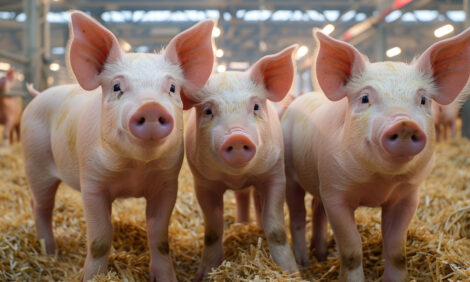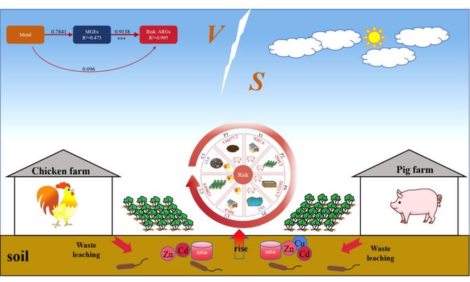



Review of the U.S Hog Market - May 2003
Our Monthly look at the trends in US Hog Market and what effect these may have on future prices - Written by James Mintert, Kansas State University.Hog Prices Turnaround
Hog prices turned around dramatically in late
April and early May.
Weekly average
national base prices reported by USDA
ranged between $48 and $49 per cwt.
(carcass weight) during most of April. But at
month’s end, base prices moved up to
average $53 and were approaching the mid-$
50’s in early May. Similarly, national net
hog prices, which include carcass premiums
and discounts, traded primarily between $51
and $52 during most of April, but moved up
to the mid-$50’s at the end of the month and
climbed into the upper $50’s during early
May.
Wholesale pork values have also
climbed sharply as USDA’s estimated pork
cutout value was about 11% higher than in
early April and approximately 19% higher
than a year ago.
The price rise coincided with a decline in
hog slaughter volume. A four-week rolling
average of federally inspected hog slaughter
tells the story.
In early March, the four-week
hog slaughter average was 3% larger than
last year.
In early April, the four-week
average was about 1% greater than in 2002.
But by early May, the four week hog
slaughter average was nearly 2% below a
year ago.
At the start of the quarter, April-June hog
slaughter was forecast to drop by 3 to 4%,
compared to last year. Through the first full
week of May, federally inspected spring
quarter slaughter was 1% smaller than in
2002. So, if slaughter expectations are
going to be met, hog slaughter is going to
have drop sharply the next few weeks.
Last year, the highest prices of the year
occurred during the January-March quarter.
That’s not likely to be the case this year.
Instead the highest prices of the year are
expected to occur during late spring and
early summer. Moreover, prices collapsed
last year in late August and early September.
That’s not likely to happen again this year as
expectations of tighter supplies should prove
supportive of prices.
 |

|
 |
 |
Cold Storage Stocks Down
Burdensome pork stocks had a negative
impact on wholesale pork and hog prices
during most of 2002. Cold storage stocks are
still large by historical standards, but have
finally dropped below last year’s inventory.
Pork cold storage stocks at the end of
February were 1.3% below a year ago, the
first year-to-year decline since November
2001. Hog slaughter below a year ago
should encourage further drawdowns of pork
cold storage stocks the rest of 2003, which
should prove supportive of wholesale pork
and hog prices.
 |
Exports Up, But So Are Imports
Pork exports during January-February were
up about 4% compared to last year. The
modest rise in total pork exports was driven
by a moderate increase in exports to Japan
(+5%) and S. Korea (+146%). But
improving exports to these two markets were
offset by smaller pork exports to Canada,
Mexico, and Russia. As a result, net pork
exports (exports minus imports) fell 22%
below a year ago during the first two months
of 2003.
Slaughter hog imports from Canada fell
sharply during January and February,
dropping 22% below a year ago. In contrast,
feeder pig imports rose about 13% compared
to 2002’s, so total hog imports were virtually
unchanged from a year ago.
 |
 |
Base Price Forecasts
National base hog prices finally started increasing seasonally as hog slaughter volume fell below a year ago. Look for base prices to trade up into the low to mid-$60’s (carcass weight) by late spring and for the spring quarter average to wind up in the mid-to upper $50’s. Year-to-year declines in hog slaughter this summer should also prove supportive of hog prices. Summer quarter base hog prices are also likely to average in the mid to upper $50’s, again supported by a year-to-year reduction in hog slaughter. Look for prices this year to be much higher than last year in late August and early September. During 2002 hog slaughter surged and prices collapsed during this time frame. Fortunately, that shouldn’t happen again this year and producers will be the beneficiaries in the form of higher prices.
Futures Based Cash Price Forecasts
Futures prices, adjusted for basis
expectations, are a source of continuously
updated cash price forecasts. As an example,
Western Corn Belt barrow and gilt price
forecasts based upon futures prices at the
time of this writing (05/09/03) settlement
prices) adjusted for basis expectations are
included in a graphical format. Basis
forecasts are based upon the most recent
three-year average basis for Western Corn
Belt barrows and gilts. To provide some
indication of the amount of risk present,
forecasts based upon the most positive and
negative basis of the last three years are also
included.
 |
Weekly updates (in graphical form) of these price forecasts are also available on the K-State Livestock & Meat Marketing Web Site (www.agecon.ksu.edu/livestock) in the weekly electronic publication entitled Hog Price & Supply Graphs.
Information provided by KSU Livestock report. For more information visit the KSU Livestock website.
Reproduced with permission.








